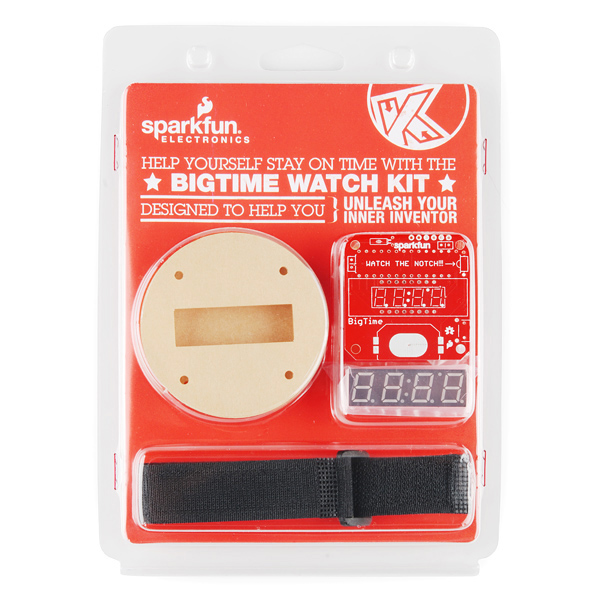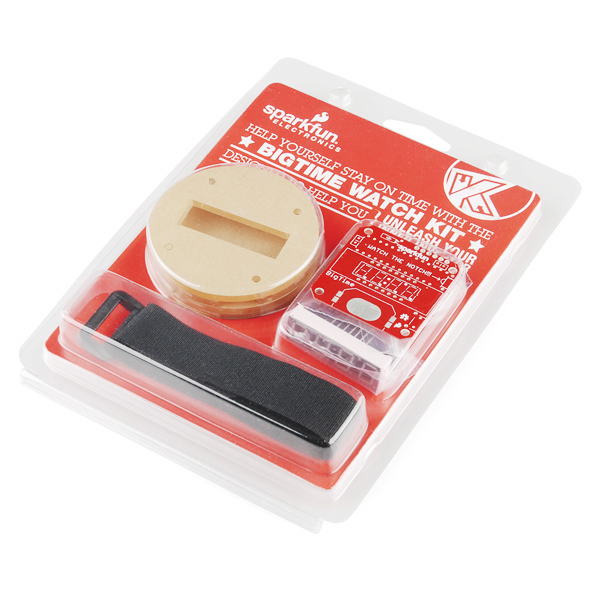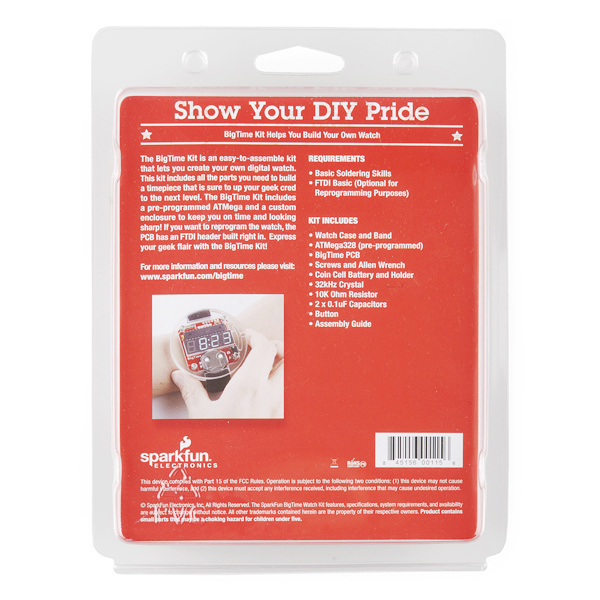BigTime Watch Kit Retail
Replacement: None. We are no longer carrying this retail kit in our catalog. The non-retail version of this kit can still be found here. This page is for reference only.
This kit is the same product as the BigTime Watch Kit but it comes in fancy clamshell packaging meant for our distributors that need it. Regular customers are welcome to order, but we want to limit the amount of extra packaging finding its way into the trash heap.
It's official, SparkFun has made the Big Time, and now you can make it too! The BigTime watch kit is a geekishly stylish digital watch with a velcro watch-band and a slick acrylic enclosure. If it seems familiar, that's because it's essentially our open-source branch from the SpikenzieLabs' Solder:Time kit. The heart of the kit is the much venerated ATMega328 using a 32kHz clock-source to keep time. To check the time, just press the button on the side of the watch and it pops up on a 4-digit 7-segment LED display. Thanks to some low-level hackery, the ATMega is running at super low power and should get an estimated 2 years of run time on a single CR2032 coin cell!
The BigTime is a through-hole kit with a low parts-count, so it makes a great project for beginning solderers. After you've finished soldering together the PCB, simply stack the acrylic pieces around it and screw them together with the included hex-head screws. Once that's done, pop in the coin-cell battery and go show off your nerd bling!
Did we mention that the watch kit is super hackable? An FTDI header is broken out to the side of the board and the watch-firmware is running on top of a bootloader! This means that all you need to do to add your own code is to open up Arduino or Wiring and select "Arduino Pro or Pro Mini 3.3V/8MHz w/ ATmega328" as your board.
- 1 x Pre-programmed ATMega328 DIP IC
- 1 x 4-Digit 7-Segment Display
- 1 x 32kHz Crystal
- 1 x 10kOhm Resistor
- 2 x 0.1uF Capacitors
- 1 x Right Angle Tactile Button
- 1 x 20mm Coin Cell Battery Holder
- 1 x 20mm Coin Cell Battery
- 4 x 4-40 Screws
- 1 x Allen Wrench
- 1 x Velcro Watch Band
- Acrylic Enclosure Parts
Assembly Guide
A soldering iron and wire cutters are the bare minimum tools required. We scoured the earth and found a really fantastic beginner's soldering iron for $10, solder for $2, and wire cutters for $2. We also have a Learn to Solder version of the kit which includes all the tools you'll need!
- Very hackable ATMega328-based kit with Arduino bootloader
- All through-hole components
- Estimated 2-year battery life
- Laser-cut acrylic enclosure
- Large, easy-to-read display
- Adjustable velcro watch-band
- Schematic
- Eagle Files
- Github (latest firmware, enclosure files, etc.)
- Assembly Guide
- Adventures in Low Power Land
BigTime Watch Kit Retail Product Help and Resources
Core Skill: Soldering
This skill defines how difficult the soldering is on a particular product. It might be a couple simple solder joints, or require special reflow tools.
Skill Level: Competent - You will encounter surface mount components and basic SMD soldering techniques are required.
See all skill levels
Core Skill: DIY
Whether it's for assembling a kit, hacking an enclosure, or creating your own parts; the DIY skill is all about knowing how to use tools and the techniques associated with them.
Skill Level: Noob - Basic assembly is required. You may need to provide your own basic tools like a screwdriver, hammer or scissors. Power tools or custom parts are not required. Instructions will be included and easy to follow. Sewing may be required, but only with included patterns.
See all skill levels
Core Skill: Electrical Prototyping
If it requires power, you need to know how much, what all the pins do, and how to hook it up. You may need to reference datasheets, schematics, and know the ins and outs of electronics.
Skill Level: Rookie - You may be required to know a bit more about the component, such as orientation, or how to hook it up, in addition to power requirements. You will need to understand polarized components.
See all skill levels
Comments
Looking for answers to technical questions?
We welcome your comments and suggestions below. However, if you are looking for solutions to technical questions please see our Technical Assistance page.
Customer Reviews
No reviews yet.





